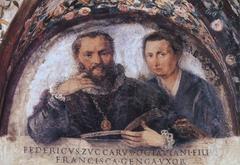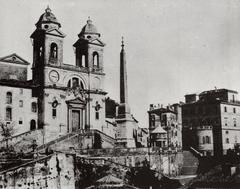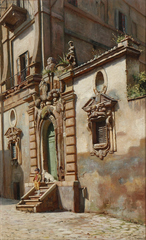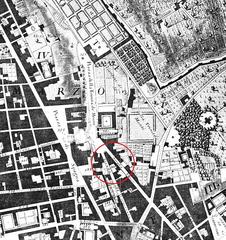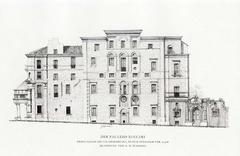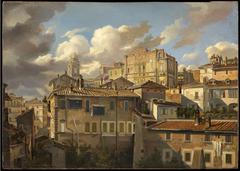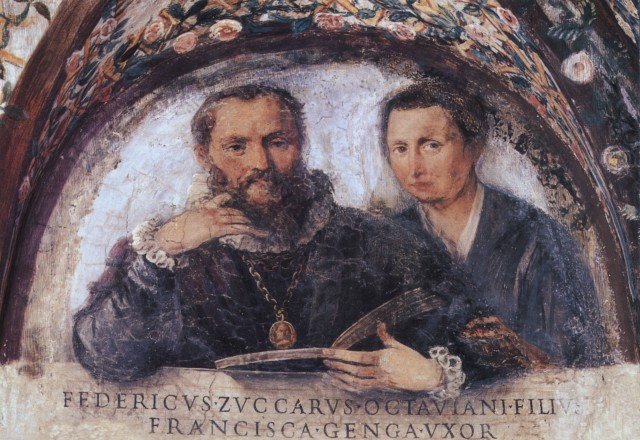
Palazzetto Zuccari: Visiting Hours, Tickets, and a Comprehensive Guide to Rome’s Mysterious “House of Monsters”
Date: 14/06/2025
Introduction
Palazzetto Zuccari, often called the “House of Monsters,” is one of the most enigmatic and visually arresting landmarks in Rome. Nestled atop the Spanish Steps at the intersection of Via Gregoriana and Via Sistina, this late Renaissance palazzo was designed by the celebrated Mannerist painter and architect Federico Zuccari between 1590 and 1594. Zuccari’s imaginative vision is evident in the building’s famous façade, where doors and windows are framed by grotesque, gaping mouths—a theatrical and symbolic motif that has fascinated visitors for centuries.
Today, Palazzetto Zuccari serves not only as a historical monument but also as the home of the prestigious Bibliotheca Hertziana – Max Planck Institute for Art History, a world-renowned center for scholarly research. While interior access is largely restricted to scholars, the building’s extraordinary exterior and occasional public tours make it a must-see for art lovers, history enthusiasts, and curious travelers alike.
This detailed guide covers Palazzetto Zuccari’s history, architectural highlights, practical visitor information (including visiting hours, tickets, and accessibility), nearby attractions, and tips to enrich your experience at this unique Rome historical site.
For more information, visit the official Bibliotheca Hertziana website, and explore further insights at Rome with View, Turismo Roma, and Romeing.
Table of Contents
- Introduction
- Historical Background and Construction
- Architectural Features and Artistic Vision
- Palazzetto Zuccari Through the Centuries
- The Biblioteca Hertziana: Research and Modern Use
- Practical Visitor Information
- Highlights and Nearby Attractions
- Tips for Visitors
- Frequently Asked Questions (FAQ)
- Plan Your Visit
- References
Historical Background and Construction
Federico Zuccari, one of the leading Mannerist artists of the late 16th century, commissioned and designed Palazzetto Zuccari as both his private residence and creative studio. Built between 1590 and 1594, the palazzo sits atop land once occupied by the ancient Gardens of Lucullus, an area historically associated with luxury and artistic patronage (Romeing). Zuccari’s reputation was cemented by his work on the Florence Cathedral and the Vatican, and he sought to create a home that would reflect not only his artistic prowess but also his fascination with the dramatic and the fantastical.
After Zuccari’s death in 1609, the building changed hands multiple times, eventually belonging to influential figures such as the Medici family and the exiled Queen of Poland, who added late Baroque modifications in the 18th century. Its layered history reflects Rome’s evolution as a center for art and culture (Turismo Roma).
Architectural Features and Artistic Vision
The most famous aspect of Palazzetto Zuccari is its façade along Via Gregoriana, where the doors and windows are framed by monstrous stone faces with wide-open mouths. This bold Mannerist motif, called the “Monster Gate,” was inspired by Zuccari’s illustrations for Dante’s “Inferno” and the fantastical sculptures of Bomarzo’s Parco dei Mostri (Rome with View). The grotesque portals are theatrical, unsettling, and distinctly memorable—a striking departure from classical harmony.
The façade also features the Zuccari family coat of arms and playful references to Zuccari’s name (“zuccaro” means “sugar” in Italian), such as sugar loaves and comets. The building’s irregular plan adapts to the Pincio hill slope and incorporates a central courtyard and once-lush garden, while the interiors were originally adorned with illusionistic frescoes and decorative stuccoes, illustrating mythological and biblical themes.
Over time, Baroque additions—including a balcony and a painted Polish coat of arms—were introduced, especially during Queen Marie Casimire’s residence in the 18th century (Wikipedia).
Palazzetto Zuccari Through the Centuries
Following its construction and initial use as Zuccari’s residence and studio, the palazzo became a gathering place for artists and intellectuals. By the late 19th century, it was acquired by Henriette Hertz, a German art patron who hosted cultural salons and amassed an extensive art library. Upon her death in 1913, Hertz bequeathed the building and her collection to the Italian state for use as a research library (Rome with View).
Significant restoration and modernization efforts were undertaken in the 20th and 21st centuries, ensuring the palazzo’s preservation while adapting it for scholarly use. Today, Palazzetto Zuccari serves as both a monument to artistic individuality and a living center for research.
The Biblioteca Hertziana: Research and Modern Use
Since 1913, Palazzetto Zuccari has housed the Bibliotheca Hertziana – Max Planck Institute for Art History (Biblioteca Hertziana). This premier research institute specializes in Italian and European art history, with a library of over 300,000 volumes, rare manuscripts, and an extensive photographic archive. The institute supports international scholars, organizes conferences, and occasionally offers public lectures and guided tours.
A major renovation in 2013, led by architect Juan Navarro Baldeweg, updated the facilities while preserving the palazzo’s historic character, skillfully blending past and present (Turismo Roma).
Practical Visitor Information
Visiting Hours
Palazzetto Zuccari does not maintain regular open hours for general visitors, as it primarily serves as a research institute. However, free guided tours are organized approximately every two months. The dates and times of these tours vary, so visitors should check the Biblioteca Hertziana website for the latest information.
- Library hours for researchers: Monday–Friday, 9:00 am – 6:00 pm
Tickets and Admission
- Admission: Free for scheduled guided tours (advance registration required)
- General entry: Not possible without joining an official tour
Accessibility
As a historic building, Palazzetto Zuccari has certain accessibility limitations. Visitors with mobility concerns should contact the library in advance to discuss possible accommodations.
Getting There
- Address: Via Gregoriana, 28, 00187 Rome, Italy
- Nearest Metro: Spagna (Line A), about a 5-minute walk
- Nearby attractions: Spanish Steps, Trinità dei Monti, Villa Medici
Guided Tours and Special Events
Public access is only available during scheduled guided tours or special events, such as Open House Rome. These tours provide a rare opportunity to view the interior, including Zuccari’s original frescoes and the lush courtyard. Advance booking is essential due to limited spaces.
Highlights and Nearby Attractions
- Monster Mouth Portals: The palazzo’s iconic sculpted entrances are a highlight for both photography and art appreciation.
- Central Courtyard and Garden: Accessible during tours, these areas showcase the palazzo’s Renaissance heritage.
- Interior Frescoes and Decor: Surviving works by Zuccari display his creative genius and narrative style.
- Biblioteca Hertziana Reading Rooms: Public viewing is possible during select tours or events.
Nearby, visitors can explore:
- Spanish Steps (Scalinata di Trinità dei Monti)
- Trinità dei Monti Church
- Villa Medici
- Via Sistina and Via Gregoriana’s boutiques and galleries
Tips for Visitors
- Plan ahead: Guided tours are infrequent and fill quickly; monitor the library’s official site for openings.
- Combine your visit: The palazzo’s location is ideal for pairing with other major sites like the Spanish Steps and Villa Medici.
- Photography: The façade is a must for photos; interior photography is generally restricted during tours.
- Accessibility: Contact the institute in advance if you have mobility concerns.
- Special events: Look out for citywide events such as Open House Rome for expanded access.
Frequently Asked Questions (FAQ)
Can I visit Palazzetto Zuccari without a guided tour?
No, access to the interior is only possible via scheduled guided tours.
Are tickets or reservations required?
Yes, tours are free but require advance booking due to limited space.
Is the palazzo wheelchair accessible?
Accessibility is limited; contact the library ahead of your visit for assistance.
Can I take photos inside?
Photography is permitted on the exterior. Interior photography depends on tour policies.
Does the palazzo host special events?
Occasionally, especially during citywide cultural initiatives. Check the library’s website for updates.
Plan Your Visit
Palazzetto Zuccari’s monstrous façade and storied past make it a captivating stop for anyone interested in Rome’s artistic heritage. To ensure an enriching experience:
- Check for upcoming guided tours and reserve your spot early.
- Combine your visit with nearby attractions for a full day of cultural exploration.
- Download the Audiala app for curated audio tours and insider tips.
- Follow official channels and local event calendars for announcements about special access days.
References
- Palazzetto Zuccari: Visiting Hours, Tickets, and History of Rome’s House of Monsters, 2025, Turismo Roma
- Palazzetto Zuccari: Visiting Hours, Tickets, History, and Architectural Highlights in Rome, 2025, Rome with View
- Palazzetto Zuccari: A Must-Visit Rome Historical Site with Visiting Hours, Tickets & Insider Tips, 2025, Walks in Rome & Biblioteca Hertziana
- Palazzetto Zuccari Visiting Hours, Tickets & Historical Guide to Rome’s Unique Monument, 2025, Romeing
- Wikipedia
- Accademia di San Luca
- Walks in Rome: Palazzetto Zuccari - House of Monsters
Palazzetto Zuccari stands as a testament to Rome’s enduring creativity and its blend of artistic innovation and scholarly tradition. Whether admired from the bustling street below or explored on a rare guided tour, it remains one of Rome’s most unforgettable architectural treasures.
